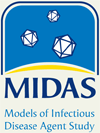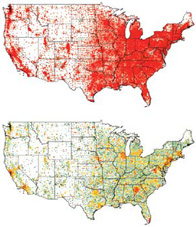
Predicting the potential spread of an infectious disease requires much more than simply connecting cities on a map. Researchers must take into account many factors about the pathogen and the affected population. To do this, scientists use computers to simulate how an infectious disease may emerge and spread through communities, countries and even continents. The results help health officials and policymakers prepare for actual outbreaks.
Why use computers to study disease?
Computers serve as virtual laboratories where researchers can study problems not easily examined in real life. The experiments consist of computer simulations—representations that closely match the demographics and geography of a real location. In these synthetic environments, researchers can introduce an infectious agent with certain characteristics and then watch it spread.
Scientists create these simulations with the help of customized programs called computational models. Different models address different questions. The ones frequently used for studying diseases are agent-based, which model how a virtual person could behave in the synthetic community. Each individual has a chance of catching or spreading an infection through encounters with others at home, work, school and elsewhere.
In constructing these models, the scientists start with assumptions about how people interact and how infectious agents spread. Onto this they add known or estimated information about actual communities and the infectious agent. They also can introduce different interventions, such as vaccination or quarantine. Researchers can change the models to simulate different situations, such as a more urban community or a more contagious virus. Finally, they analyze and compare the outcomes to better understand how an outbreak could spread in a variety of scenarios.
Because no single set of results or single model can predict exactly what will happen, scientists often will ask different models the same questions. When different models yield similar results, researchers have more confidence in the predictions.
Who builds the models?
Since May 2004, a network of researchers has been building computational models of infectious disease outbreaks. The network is called MIDAS, for Models of Infectious Disease Agent Study. It currently receives about $13 million a year from the National Institute of General Medical Sciences (NIGMS), part of the National Institutes of Health.
Because the development and operation of the MIDAS models require a breadth of knowledge, the network draws together an interdisciplinary team of researchers with expertise in epidemiology, infectious diseases, computational biology, statistics, social sciences, physics, computer sciences and informatics.

 In 2006, MIDAS modelers simulated the spread of pandemic flu in the United States. Each dot changes from green to red as more people in that area get sick.
In 2006, MIDAS modelers simulated the spread of pandemic flu in the United States. Each dot changes from green to red as more people in that area get sick. The top map shows what could happen with no intervention; the bottom map shows the effect of giving people a less effective vaccine while a better one is being developed.Proceedings of the National Academy of Sciences
The top map shows what could happen with no intervention; the bottom map shows the effect of giving people a less effective vaccine while a better one is being developed.Proceedings of the National Academy of SciencesWhat diseases does MIDAS model?
The MIDAS network focuses on infectious disease outbreaks, whether they occur naturally or deliberately. The investigators work together to prioritize which infectious diseases will be modeled based on the potential impact of the models and the availability of information on which to build the models. Right now, the MIDAS researchers are focusing on flu, methicillin-resistant Staphylococcus aureus (MRSA), cholera, dengue fever, malaria and tuberculosis.
What do the MIDAS models show?
When MIDAS started, the public health community feared that a flu strain emerging in Southeast Asia soon would spread worldwide. To help prepare and prevent such an event, MIDAS scientists modeled a flu pandemic. Their initial models examined the potential effectiveness of different interventions, including vaccinating people before an outbreak, distributing antiviral medications, closing schools and quarantining infected individuals. The results suggested that a combination of measures, if implemented early and in a particular way, might contain spread.
This early work helped MIDAS scientists use models to study H1N1 or “swine flu,” the first actual pandemic flu strain since 1968. Beginning in April 2009, they used incoming data to simulate spread, identify at-risk groups and evaluate potential health impact with and without intervention. Their work indicated that early vaccination of school children best reduced disease while vaccinating elders became more important later on. These results suggest that the effectiveness of different vaccination strategies may vary during a pandemic. The modeling experiments also indicated that people at risk for serious complications—including those who are pregnant or have certain pre-existing health problems—should be given antivirals to take at the first signs of illness.
Who uses the MIDAS results?
The MIDAS network publishes its results in peer-reviewed scientific journals for broad use and collaborates with federal and international agencies to aid the development of policies related to infectious diseases. Current U.S. guidance for slowing a pandemic flu attack without pharmaceutical interventions is based on MIDAS modeling results.
Want to know more about MIDAS?
Visit http://www.nigms.nih.gov/Research/FeaturedPrograms/MIDAS.
Who leads the MIDAS network?
Visit http://www.nigms.nih.gov/Research/FeaturedPrograms/MIDAS/network.htm
Learn more:
Computing Diseases from Computing Life
Forecasting Flu
Solving the Sleeping Sickness 'Mystery'
Social Studies: Profile of Stephen Eubank
NIGMS is a part of the National Institutes of Health that supports basic research to increase our understanding of life processes and lay the foundation for advances in disease diagnosis, treatment and prevention. For more information on the Institute's research and training programs, see http://www.nigms.nih.gov.
Content reviewed November 2012